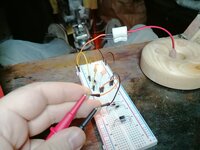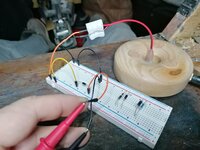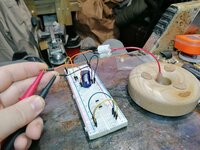BearOfThunder
Newbie level 5
I am new to electronics, so I come here for some help to understand what to do.
I have a practical problem so let me just explain what i have and what i am trying achieve.
I am an artist and i make sculptures. I use wireless power transfer to light up LEDs inside my sculptures.
Here is a link to the electronics I am using: https://www.aliexpress.com/item/32944450041.html?spm=a2g0s.9042311.0.0.27424c4d4nsB8n
The nice thing about this solution is that the sculpture, which is meant to be held and handeled, lights up when it is put back on it's plinth.
I would like to add an extra feature to the scultures, and that is to have the light inside the sculpture hold it's light for some time after it is removed from it's plinth. Like the plinth charges it up like a power station, and when the sculture is removed it holds a slowly fading light for between 10 seconds or more. I feel like this would create another element of "magic" to my sculptures.
What I have tried so far is to buy a 6F 2.7v (super-)capacitor. Maybe this is totally wrong capacitor, i have no idea. I have played around with it, but I can't find any way to charge the capacitor with the wireless power from the transmitter. The charging have to happen through the recieving coil inside the sculpture.
I know the capacitor is working because i can charge it up by touching it to a 9V batteri for half a second. I know the voltage of the battery is wrong, but half a second of contact does not seem to harm the capacitor. With this short touch the capacitor can light up one LED (1W) for about 10 minutes....slowly fading all the time. 10 minutes are more than i need, so I really don't know what capacitor to use.
If you follow the link above to the transmitter and receivers I am using, you will see that the transmitting coil is about 75mm in diameter, while the receiving coils are only 14.5mm in diameter. The transmitter can give up to 700mA, and can light up many receivers, but for relatively bright light about 3 receivers seem to be the limit. I use only one or two in my sculptures.
I use 1W LEDs rated to use about 300mA when bright, but the LED light up at far lower input, and that is ok if it is just bright enough.
I have tried to measure the Voltage in the recieving coil and get about 80-120mV reading. I am not sure if this reading is accurate, but the LED lights up quite well anyways. There seems to be a tiny diode or capacitor connected to the receiving coil, but the funny thing is that the LEDs does not care what is plus and what is minus, they light up in any direction. I can't say that this is puzzling to me, since i don't really know what happens here, but it does not seem to fit with what i read different places about LEDs. The brightness of the LED is of course dependent on the position in relation to the transmitter...max seems to be about 4 cm over the transmitter in the center and on the same plane.
As stated before I can't get any charge into the capacitor I have with this low current from a recieving coil, so I probably need a different capacitor, but maybe also other components to make this work. What I have noticed is that if i connect this capacitor in parallell with the LED (receiving coil, capacitor and LED in parallell and put the receiver in the transmitter), then the LED will not light up at all, and no charge I can use seems to have built up in the capacitor while i do this.
That is all information i can think of at this point, please ask if you need details to help me with this.
Can anyone help me get this to work the way I want it?
I have a practical problem so let me just explain what i have and what i am trying achieve.
I am an artist and i make sculptures. I use wireless power transfer to light up LEDs inside my sculptures.
Here is a link to the electronics I am using: https://www.aliexpress.com/item/32944450041.html?spm=a2g0s.9042311.0.0.27424c4d4nsB8n
The nice thing about this solution is that the sculpture, which is meant to be held and handeled, lights up when it is put back on it's plinth.
I would like to add an extra feature to the scultures, and that is to have the light inside the sculpture hold it's light for some time after it is removed from it's plinth. Like the plinth charges it up like a power station, and when the sculture is removed it holds a slowly fading light for between 10 seconds or more. I feel like this would create another element of "magic" to my sculptures.
What I have tried so far is to buy a 6F 2.7v (super-)capacitor. Maybe this is totally wrong capacitor, i have no idea. I have played around with it, but I can't find any way to charge the capacitor with the wireless power from the transmitter. The charging have to happen through the recieving coil inside the sculpture.
I know the capacitor is working because i can charge it up by touching it to a 9V batteri for half a second. I know the voltage of the battery is wrong, but half a second of contact does not seem to harm the capacitor. With this short touch the capacitor can light up one LED (1W) for about 10 minutes....slowly fading all the time. 10 minutes are more than i need, so I really don't know what capacitor to use.
If you follow the link above to the transmitter and receivers I am using, you will see that the transmitting coil is about 75mm in diameter, while the receiving coils are only 14.5mm in diameter. The transmitter can give up to 700mA, and can light up many receivers, but for relatively bright light about 3 receivers seem to be the limit. I use only one or two in my sculptures.
I use 1W LEDs rated to use about 300mA when bright, but the LED light up at far lower input, and that is ok if it is just bright enough.
I have tried to measure the Voltage in the recieving coil and get about 80-120mV reading. I am not sure if this reading is accurate, but the LED lights up quite well anyways. There seems to be a tiny diode or capacitor connected to the receiving coil, but the funny thing is that the LEDs does not care what is plus and what is minus, they light up in any direction. I can't say that this is puzzling to me, since i don't really know what happens here, but it does not seem to fit with what i read different places about LEDs. The brightness of the LED is of course dependent on the position in relation to the transmitter...max seems to be about 4 cm over the transmitter in the center and on the same plane.
As stated before I can't get any charge into the capacitor I have with this low current from a recieving coil, so I probably need a different capacitor, but maybe also other components to make this work. What I have noticed is that if i connect this capacitor in parallell with the LED (receiving coil, capacitor and LED in parallell and put the receiver in the transmitter), then the LED will not light up at all, and no charge I can use seems to have built up in the capacitor while i do this.
That is all information i can think of at this point, please ask if you need details to help me with this.
Can anyone help me get this to work the way I want it?


